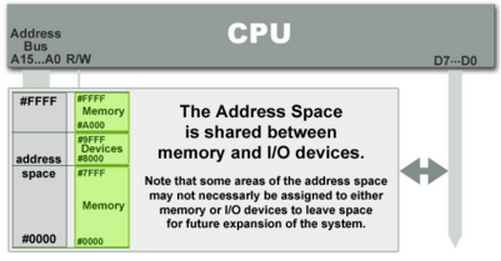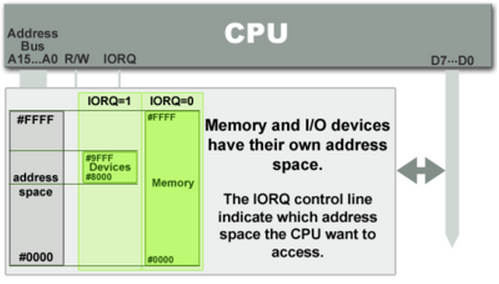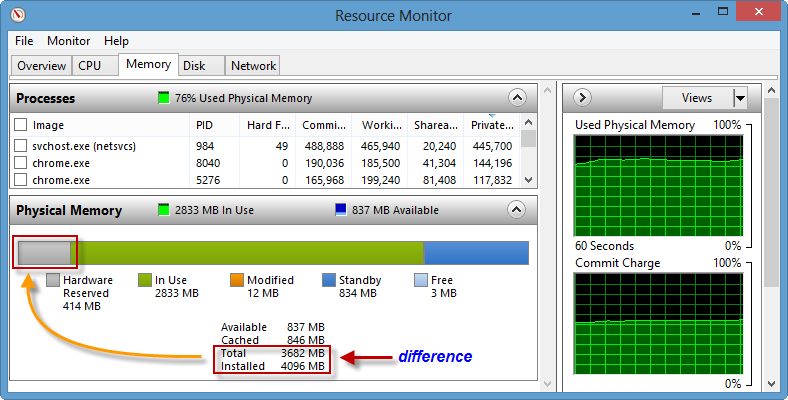Memory-mapped I/O vs port-mapped I/O
2015-06-01 23:14
337 查看
关于MMIO和PIO,我看到的解释最清楚的文章,原文在这里:Memory-mapped I/O vs port-mapped I/O - 2015
Microprocessors normally use two methods to connect external devices: memory mapped or port mapped I/O. However, as far as the peripheral is concerned, both methods are really identical.
Memory mapped I/O is mapped into the same address space as program memory and/or user memory, and is accessed in the same way.
Port mapped I/O uses a separate, dedicated address space and is accessed via a dedicated set of microprocessor instructions.
The difference between the two schemes occurs within the microprocessor. Intel has, for the most part, used the port mapped scheme for their microprocessors and Motorola has used the memory mapped scheme.
As 16-bit processors have become obsolete and replaced with 32-bit and 64-bit in general use, reserving ranges of memory address space for I/O is less of a problem, as the memory address space of the processor is usually much larger than the required space for all memory and I/O devices in a system.
Therefore, it has become more frequently practical to take advantage of the benefits of memory-mapped I/O. However, even with address space being no longer a major concern, neither I/O mapping method is universally superior to the other, and there will be cases where using port-mapped I/O is still preferable.
Memory-mapped IO (MMIO)

Picture source : IO Devices
I/O
devices are mapped into the system memory map along with RAM and ROM.
To access a hardware device, simply read or write to those 'special'
addresses using the normal memory access instructions.
The advantage to this method is that every instruction which can access memory can be used to manipulate an I/O device.
The
disadvantage to this method is that the entire address bus must be
fully decoded for every device. For example, a machine with a 32-bit
address bus would require logic gates to resolve the state of all 32
address lines to properly decode the specific address of any device.
This increases the cost of adding hardware to the machine.
Port-mapped IO (PMIO or Isolated IO)

Picture source : IO Devices
I/O
devices are mapped into a separate address space. This is usually
accomplished by having a different set of signal lines to indicate a
memory access versus a port access. The address lines are usually shared
between the two address spaces, but less of them are used for accessing
ports. An example of this is the standard PC which uses 16 bits of port
address space, but 32 bits of memory address space.
The
advantage to this system is that less logic is needed to decode a
discrete address and therefore less cost to add hardware devices to a
machine. On the older PC compatible machines, only 10 bits of address
space were decoded for I/O ports and so there were only 1024 unique port
locations; modern PC's decode all 16 address lines. To read or write
from a hardware device, special port I/O instructions are used.
From a software perspective, this is a slight disadvantage because more
instructions are required to accomplish the same task. For instance, if
we wanted to test one bit on a memory mapped port, there is a single
instruction to test a bit in memory, but for ports we must read the data
into a register, then test the bit.
Comparison - Memory-mapped vs port-mapped
Resource Monitor
We can check the reserved memory address space from the Resource Monitor via our desktop's Task Manager.

Microprocessors normally use two methods to connect external devices: memory mapped or port mapped I/O. However, as far as the peripheral is concerned, both methods are really identical.
Memory mapped I/O is mapped into the same address space as program memory and/or user memory, and is accessed in the same way.
Port mapped I/O uses a separate, dedicated address space and is accessed via a dedicated set of microprocessor instructions.
The difference between the two schemes occurs within the microprocessor. Intel has, for the most part, used the port mapped scheme for their microprocessors and Motorola has used the memory mapped scheme.
As 16-bit processors have become obsolete and replaced with 32-bit and 64-bit in general use, reserving ranges of memory address space for I/O is less of a problem, as the memory address space of the processor is usually much larger than the required space for all memory and I/O devices in a system.
Therefore, it has become more frequently practical to take advantage of the benefits of memory-mapped I/O. However, even with address space being no longer a major concern, neither I/O mapping method is universally superior to the other, and there will be cases where using port-mapped I/O is still preferable.
Memory-mapped IO (MMIO)

Picture source : IO Devices
I/O
devices are mapped into the system memory map along with RAM and ROM.
To access a hardware device, simply read or write to those 'special'
addresses using the normal memory access instructions.
The advantage to this method is that every instruction which can access memory can be used to manipulate an I/O device.
The
disadvantage to this method is that the entire address bus must be
fully decoded for every device. For example, a machine with a 32-bit
address bus would require logic gates to resolve the state of all 32
address lines to properly decode the specific address of any device.
This increases the cost of adding hardware to the machine.
Port-mapped IO (PMIO or Isolated IO)

Picture source : IO Devices
I/O
devices are mapped into a separate address space. This is usually
accomplished by having a different set of signal lines to indicate a
memory access versus a port access. The address lines are usually shared
between the two address spaces, but less of them are used for accessing
ports. An example of this is the standard PC which uses 16 bits of port
address space, but 32 bits of memory address space.
The
advantage to this system is that less logic is needed to decode a
discrete address and therefore less cost to add hardware devices to a
machine. On the older PC compatible machines, only 10 bits of address
space were decoded for I/O ports and so there were only 1024 unique port
locations; modern PC's decode all 16 address lines. To read or write
from a hardware device, special port I/O instructions are used.
From a software perspective, this is a slight disadvantage because more
instructions are required to accomplish the same task. For instance, if
we wanted to test one bit on a memory mapped port, there is a single
instruction to test a bit in memory, but for ports we must read the data
into a register, then test the bit.
Comparison - Memory-mapped vs port-mapped
| Memory-mapped IO | Port-mapped IO |
|---|---|
| Same address bus to address memory and I/O devices | Different address spaces for memory and I/O devices |
| Access to the I/O devices using regular instructions | Uses a special class of CPU instructions to access I/O devices |
| Most widely used I/O method | x86 Intel microprocessors - IN and OUT instructions |
Resource Monitor
We can check the reserved memory address space from the Resource Monitor via our desktop's Task Manager.

相关文章推荐
- Cocos2d-x 详解坐标系统
- viewWillAppear
- android studio引入第三方jar包
- viewWillAppear/viewDidAppear/viewWillDisappear/viewDidDisappear
- marki-制作.9格式的素材图片
- Android Resources$NotFoundException: String resource ID #0x1
- Android动画之translate(位移动画)
- Android 实现记住用户名和密码的功能
- [016] 如何使用真机调试Android应用
- [014] Android应用程序签名详解
- [015] Android平台的专业术语
- iOS键盘与NSLayoutConstraint
- [013] 百度地图API之城市POI搜索-获取所有结果(Android)
- [012] 百度地图API之公交换乘方案搜索(Android)
- [011] 百度地图API之POI搜索-发现你身边的兴趣点,如超市、餐厅、ATM...(Android)
- [010] 百度地图API之根据经纬度查询地址信息(Android)
- ios动画学习(二)
- [009] 百度地图API之MyLocationOverlay的使用(Android)
- [008] 百度地图API之ItemizedOverlay的使用(Android)
- objective-C 的内存管理之-自动释放池(autorelease pool)
